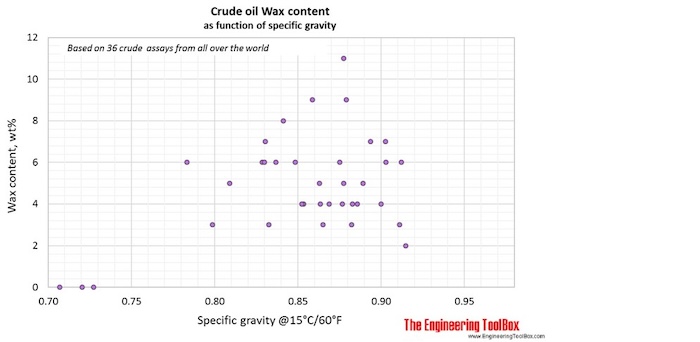Crude Oil Properties - Standard test methods (ASTM and others)
An overview of common test methods and typical ranges of variation of petroleum quality parameters. What, why and how do the different test?
Due to commercial, safety, enviromental, quality and processing reasons, there is a huge number of quality parameters and related test methods for crude oils used by different actors. This document gives a short description of the main standard test methods used for crude oil.
Typical ranges of variation of the quality parameters between different crude oils are also given.
Detailed and updated versions of methods are avaliable for purchase at ASTM and other vendors. See also Standard test methods and specifications for petroleum products
(links directly to the tests)
Acidity, TAN - total acid number
What:
The determination of the sum of all acid compounds present in petroleum samples. TAN is expressed in mg of KOH per g of sample. The acid number is a measure of the amount of acidic substance in the oil.
Why:
The TAN value indicates to the crude oil refinery the potential of corrosion problems. It is usually the naphthenic acids in the crude oil that cause corrosion problems. This type of corrosion is referred to as naphthenic acid corrosion (NAC).
How:
ASTM D664 Standard Test Method for Acid Number of Petroleum Products by Potentiometric Titration:
The sample is dissolved in toluene and propanol with a little water and titrated with alcoholic potassium hydroxide. A glass electrode and reference electrode is immersed in the sample and connected to a voltmeter/potentiometer. The meter reading (in millivolts) is plotted against the volume of titrant. The end point is taken at the distinct inflection of the resulting titration curve corresponding to the basic buffer solution.
Alternative test methods: ISO 6618, ASTM D974, BS DIN EN 12634, IP 449
Typical range of variation: TAN of 0.01 - 3.0 mg KOH/g in crude oil
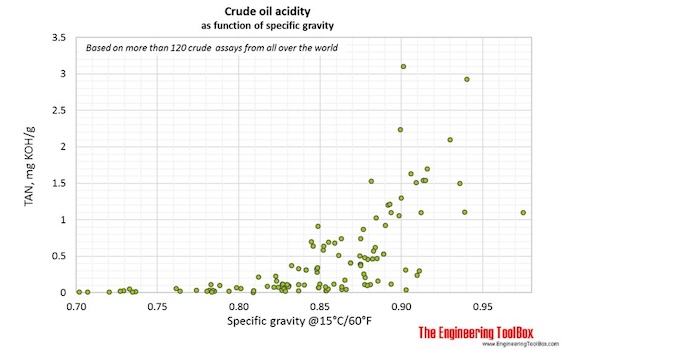
Asphaltenes, C7
What:
Determination of the heptane insoluble asphaltene content of gas oil, diesel fuel, residual fuel oils, lubricating oil, bitumen, and crude petroleum that has been topped to an oil temperature of 260°C.
Why:
Asphaltenes are the organic molecules of highest molecular mass and carbon-hydrogen ratio normally occurring in crude petroleum and petroleum products containing residual material. They may give problems during storage and handling if the suspension of asphaltene molecules is disturbed through excess stress or incompatibility. They are also the last molecules in a product to combust completely, and thus may be one indicator of black smoke propensity. Their composition normally includes a disproportionately high quantity of the sulfur, nitrogen, and metals present in the crude petroleum or petroleum product.
How:
ASTM D6560 Standard Test Method for Determination of Asphaltenes (Heptane Insolubles) in Crude Petroleum and Petroleum Products:
A test portion of the sample is mixed with heptane and the mixture heated under reflux, and the precipitated asphaltenes, waxy substances, and inorganic material are collected on a filter paper. The waxy substances are removed by washing with hot heptane in an extractor. After removal of the waxy substances, the asphaltenes are separated from the inorganic material by dissolution in hot
toluene, the extraction solvent is evaporated, and the asphaltenes weighed.
Alternative test methods: ASTM D3279
Typical range of variation: 0 - 10 wt% C7 insoluble asphaltenes in crude oil
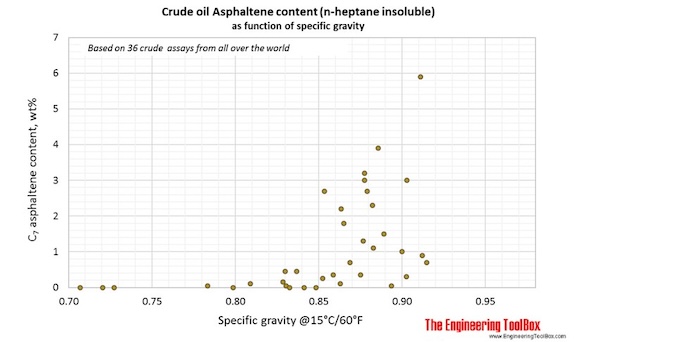
Carbon, hydrogen and nitrogen content
What:
Instrumental determination of carbon, hydrogen, and nitrogen in laboratory samples of crude oil, petroleum products and lubricants. Values obtained represent the total carbon, the total hydrogen, and the total nitrogen. These test methods were tested in the concentration range of at least 75 to 87 mass % for carbon, at least 9 to 16 mass % for hydrogen, and <0.1 mass="" to="" 2="" for="" nitrogen="" --0="" 1--="">
Why:
Carbon, hydrogen, and particularly nitrogen analyses are useful in determining the complex nature of sample types covered by this test method. The CHN results can be used to estimate the processing and refining potentials and yields in the petrochemical industry. The concentration of nitrogen in petroleum product is a measure of the presence of nitrogen containing additives. Knowledge of its concentration can be used to predict performance. Crude oil and some petroleum products also contain naturally occurring nitrogen. Knowledge of hydrogen content in samples is helpful in addressing their performance characteristics. Hydrogen to carbon ratio is useful to assess the performance of upgrading processes.
How:
ASTM D5291 Standard Test Methods for Instrumental Determination of Carbon, Hydrogen, and Nitrogen in Petroleum Products and Lubricants:
A variety of instrumental components and configurations can be satisfactorily utilized for these test methods. Functionally, the following are specified for all instruments: The conditions for combustion of the sample must be such that the subject components are completely converted to carbon dioxide, water vapor, and nitrogen or nitrogen oxides. Instrumental conditions include availability of the oxidant, temperature, and time. Representative aliquots of the combustion gases must then be treated to liberate (as water vapor) hydrogen present as hydrogen halides and sulfur oxyacids, and to reduce (to the element) nitrogen present as nitrogen oxides. The water vapor and nitrogen so obtained must be included with the materials originally present in these aliquots. Additional treatment of the aliquots (prior to detection) depends on the detection scheme utilized for the instrument. The detection system must determine the analytical gases individually and without interference. The detectors must provide linear responses with respect to concentration over the full range of possible concentrations from the applicable samples, or the system must include provisions for appropriately evaluating nonlinear responses so that they can be accurately correlated with these concentrations. The instrument must include an appropriate readout device for the detector responses.
Alternative test methods:
Typical range of variation:
Carbon: 84 - 87 wt% Carbon in crude oil
Hydrogen: 12 - 15 wt% Hydrogen in crude oil
Nitrogen: 100 - 4000 mg/kg Nitrogen in crude oil (lower in condensates)

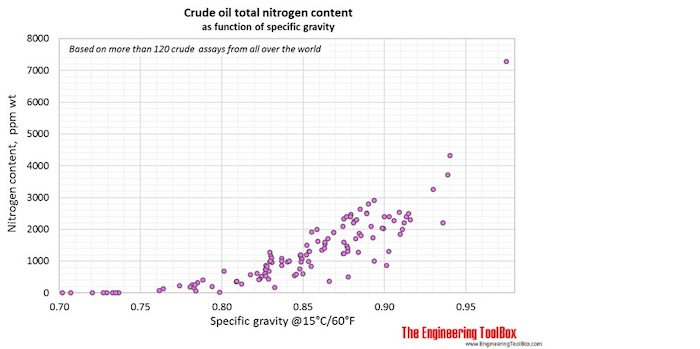
Back to Content Boiling and melting points, density, structure and molweight of organic nitrogen compounds
Carbon residue
What:
Determination of the amount of carbon residue ("coke") formed after evaporation and pyrolysis of petroleum materials.
Why:
The carbon residue value of the various petroleum materials serves as an approximation of the tendency of the material to form carbonaceous type deposits under degradation conditions similar to those used in the test method. It can be used to provide some indication of the relative coke forming tendency of such materials.
How:
ASTM D45 30 Standard Test Method for Determination of Carbon Residue (Micro Method):
A weighed quantity of sample is placed in a glass vial and heated to 500°C under nitrogen atmosphere for a specific time. The sample undergoes coking reactions, and volatiles formed are swept away by the nitrogen. The carbonaceous-type residue remaining is reported as a percent of the original sample as “carbon residue (micro).”
ASTM D524 Standard Test Method for Ramsbottom Carbon Residue of Petroleum Products:
The principle consists on heating a sample at 550°C during 20 min. in a coking bulb and then weighing the residue. The test method is limited to those samples that are mobile below 90 °C.
Values obtained by D524 are not numerically the same as those obtained by Test Method D189 or D4530. Approximate correlations have been derived but need not apply to all materials which can be tested because the carbon residue test is applicable to a wide variety of petroleum products.
Alternative test methods: ASTM D189, JIS K2270, ISO 10370
Typical range of variation: 0 - 12 wt% carbon residue in crude oil
Density@15°C ( Gravity)
What:
Determination of the density or relative density of petroleum distillates and viscous oils that can be handled in a normal fashion as liquids at test temperatures between 15 and 35°C. Its application is restricted to liquids with vapor pressures below 600 mm Hg (80 kPa) and viscosities below about 15 000 cSt (mm2/s) at the temperature of test.
Why:
Density: Mass of a substance per unit volume. Density is a fundamental physical property that can be used in conjunction with other properties to characterize both the light and heavy fractions of petroleum and petroleum products. Determination of the density or relative density of petroleum and its products is necessary for the conversion of measured volumes to volumes at the standard temperature of 15°C. Density is important for consistency and good fuel economy. Higher density produces more power and more smoke.
How:
ASTM D4052 Standard Test Method for Density and Relative Density of Liquids by Digital Density Meter:
A small volume of liquid sample is introduced into an oscillating sample tube and the change in oscillating frequency caused by the change in the mass of the tube is used in conjunction with calibration data to determine the density of the sample.
Alternative test methods: ASTM D1298, IP 160 and IP 365, ISO 3675, ISO 12185, JIS K 2249
Typical range of variation: 700 - 1000 kg/m3 or 10 - 70 °API for crude oils at 15°C (D ue to high viscosity, t he most heavy crude oils are diluted to lower gravity befor e introduction to the marked)
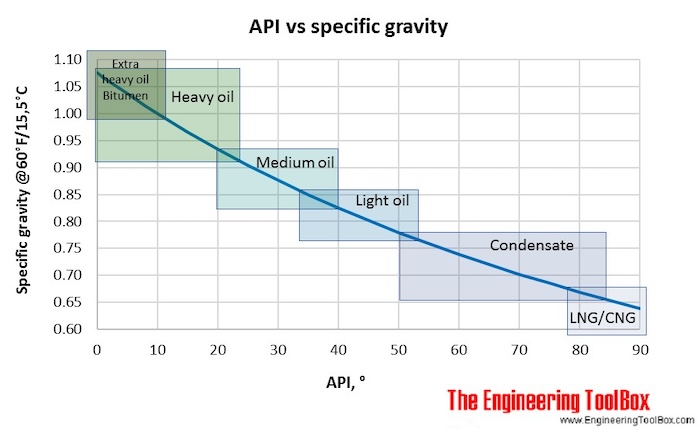
Density - Gravity API Gravity
Distillation
What:
Method D2892 covers the procedure for the distillation of stabilized crude petroleum to a final cut temperature of 400 °C Atmospheric Equivalent Temperature (AET). Method D5236 covers the procedure for distillation of heavy hydrocarbon mixtures having initial boiling points greater than 150°C (300°F), such as heavy crude oils, petroleum distillates, residues, and synthetic mixtures. These two methods are combined to give a complete distilliation of whole crudes to atmospheric and vacuum fractions.
Why:
Distillation (volatility) characteristics of hydrocarbons are important for their safety and performance. The boiling range gives information on the composition, properties and behavior during storage and use. Volatility is the major determinant of the tendency of a hydrocarbon mixture to produce potentially explosive vapors. These tests are conducted on a crude oil to determine its value. It provides an estimate of the yields of fractions of various boiling ranges and is therefore valuable in technical discussions of a commercial nature. These test methods correspond to the standard laboratory distillation efficiency referred to as 15/5. The fractions produced can be analyzed as produced or combined to produce samples for analytical studies, engineering, and product quality evaluations. The preparation and evaluation of such blends is not part of this test method.
How:
ASTM D2892 Standard Test Method for Distillation of Crude Petroleum (15-Theoretical Plate Column):
A weighed sample of 1 to 30 L of stabilized crude petroleum is distilled to a maximum temperature of 400°C AET in a fractionating column having an efficiency at totalreflux of at least 14, but not greater than 18, theoretical plates. A reflux ratio of 5:1 is maintained at all operating pressures, except that at the lowest operating pressures be-tween 0.674 and 0.27 kPa (5 and 2 mm Hg), a reflux ratio of 2:1 is optional. In cooperative testing or in cases of dispute, thestages of low pressure, the reflux ratios, and the temperaturesof cut points must be mutually agreed upon by the interestedparties prior to beginning the distillation. Observations of temperature, pressure, and other variables are recorded at intervals and at the end of eachcut or fraction. The mass and density of each cut or fractio are obtained. Distillation yields by mass are calculated from the mass of all fractions, including liquified gas cut and theresidue. Distillation yields by volume of all fractions and the residue at 15°C are calculated from mass and density. From these data the TBP curves in mass or volume %, or both, versus AET are drawn.
ASTM D5236 Standard Test Method for Distillation of Heavy Hydrocarbon Mixtures (Vacuum Potstill Method):
A weighed volume of sample is distilled at absolute pressures between 6.6 and 0.013 kPa (50 and 0.1 mm Hg) at specified distillation rates. Cuts are taken at preselected temperatures. Records of vapor temperature, operating pressure, and other variables are made at intervals, including at each cutpoint. The mass of each fraction is obtained. Distillation yields by mass are calculated from the mass of each fraction relative to the total mass recovery. The density of each fraction is obtained. Distillation yields by volume are calculated from the volume computed for each fraction at 15°C (59°F) relative to the total recovery.
Alternative test methods: ISO 3405, JIS K 2258, ASTM D2887, ASTM 7169, IP 545
Typical range of variation :
The volume of the different distillation fractions vary a lot from light to heavy crudes. There are two ways to compare crude fraction yields:
1. The temperatures where a certain volume fraction has been recovered in the distillation. The lowest temperature for the lightest crudes:
5% recovery: 15-150°C
10% recovery: 25-220°C
50% recovery: 65-450°C
90% recovery: 160-700°C
95% recovery: 210-760°C
2. The volume fractions recovered at certain temperature intervals. Light crudes contain most naphtha, kerosene and gas oil while heavy crudes have most gas oil, vacuum gasoil and residue :
Gas (C4 -), -16°C (-60°F): 0-5 vol%
Light naphtha, 16-74°C (60 - 165°F): 0-55 vol%
Heavy naphtha, 74-166°C (165-330°F): 5-45 vol%
Kerosene, 166-249°C (330-480°C): 3-30 vol%
Gas oil (diesel), 249-343 °C (480-650°F): 2-35 vol%
Vacuum gas oil (VGO), 343-538°C (650-1000°F): 1-40 vol%
Vacuum residue, 538°C+ (1000°F+): 0-35 vol%
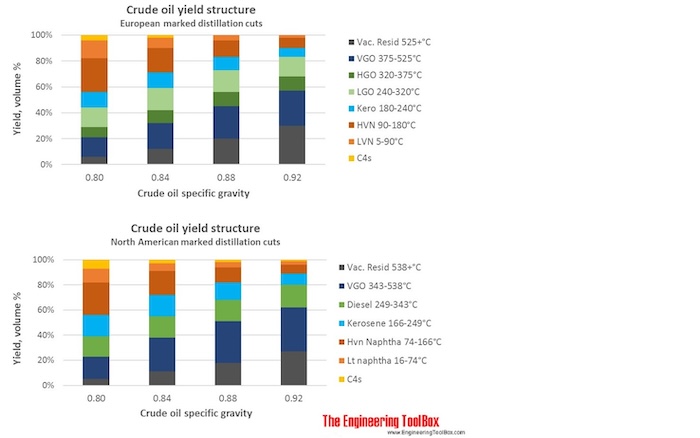

Back to Content Yield structure of crude oils with increasing density of crude
Hydrocarbons, light end of crude
What:
Determination, speciation and quantification of light hydrocarbons and cut point intervals in live crude oils and condensates with vapour pressure (VPCR4 ) up to 500 kPa at 37.8 °C. Samples containing mass fractions of up to 0.5 % methane, 2.0 % ethane, 10 % propane, or 15 % isobutane may be analyzed. A mass fraction with a lower limit of 0.001 % exists for these compounds. The test method may be used for the determination of cut point carbon fraction intervals of live crude oils and condensates from initial boiling point (IBP) to 391 °C (nC24 ).
Why:
Determination of light hydrocarbons in crude oil and condensates without depressurizing, thereby avoiding the loss of highly volatile components and maintaining sample integrity. This test method provides a highly resolved light end profile which can aid in determining and improving appropriate safety measures and product custody transport procedures. Decisions in regards to marketing, scheduling and processing of crude oils may rely on light end compositional results. Equation of state calculations can be applied to variables provided by this method to allow for additional sample characterization.
How:
ASTM D8003 Standard Test Method for Determination of Light Hydrocarbons and Cut Point Intervals in Live Crude Oils and Condensates by Gas Chromatography
Analysis of live crude oils and condensates by gas chromatography without depressurizing. A heated, pressurized liquid injection system (HPLIS) is used. Methane (nC1) to hexane (nC6) including iC5, benzene, and benzene precursors are speciated and quantitated, and reported as wt% of crude. Also good resolution for C7 fraction, which can be separated and reported as C7 paraffins, naphthenes and toluen. Cut point carbon fraction intervals from initial boiling point to nC24. nC24+ plus fraction reported.
Alternative test methods: ASTM D7169 in combination with D7900
T ypical range of variation (all in wt% of crude) :
Methan+ ethane: 0.02 - 0.07
Propane: 0.00 - 0.2
Isobutane: 0.04 - 0.1
N-butane: 0.2 - 1.0
Isopentane: 0.2 - 8.0
N-pentane: 0.2 - 9.0
Cyclopentane: 0.1 - 0.8
C6 paraffins: 0.6 -12.5
C6 naphthenes: 0.6 - 6.0
Benzene: 0.02 - 2.5
C <7 paraffins: 0.6 - 8.0
C7 naphthenes: 1.3 - 8.0
Toluene: 0.1 - 3.5
Hydrogen sulphide, dissolved
What:
Test methods covering procedures for the determination of the hydrogen sulfide (H2S) content of fuel oils such as marine residual fuels and blend stocks, with viscosity up to 3000 mm2s-1 at 50 °C, and marine distillate fuels, as measured in the liquid phase (ASTM D7621), or in gasoline, naphtha, light cycle oils and similar distillates that are liquid at ambient temperature and pressure (UOP-163). The lower limit of quantitation is 0.2 mass-ppm mercaptan (as sulfur) and 1.0 mass-ppm hydrogen sulfide (as sulfur).
Why:
Excessive levels of hydrogen sulfide in the vapor phase above oils in storage tanks can result in health hazards, violation of local occupational health and safety regulations, and public complaint. An additional concern is corrosion that can be caused by the presence of H2S during refining or other activities. Control measures to maintain safe levels of H2S require a precise method for the measurement of potentially hazardous levels of H2S in oils.
How:
ASTM D7621 Standard Test Method for Determination of Hydrogen Sulfide in Fuel Oils by Rapid Liquid Phase Extraction:
Procedure A has been shown to eliminate interferences such as thiols (mercaptans) and alkyl sulfides. Procedure B can give elevated results if such interferences are present
UOP-163 Hydrogen Sulfide and Mercaptan Sulfur in Liquid Hydrocarbons by Potentiometric Titration:
The liquid ydrocarbon sample is weighed into 2-propanol containing a small amount of ammonium hydroxide. The solution is totrated potentiometrically with alcoholic silver nitrate using a glass refernce and silver-silver sulfide indicating electrode system. Hydrogen sulfide and mercaptan sulfur concentrations are calculated as mass ppm. Free sulfur complicates the potentiometric curve and instructions are given for interpreting the curve when free sulfur is present.
Alternative test methods: IP 570, ISO 82717, ASTM D6021
T ypical range of variation : 0 - 5 ppm H2S in crude oils
Nitrogen, basic
What:
A method for determining basic organic nitrogen in petroleum distillates. This method may be applied to both colored and clear samples with no difficulty. The range of detection for petroleum distillates is from 0.0001 to 1.0 mass-% nitrogen, while for viscous materials, such as heavy oils, the range is 0.001 to 5.00 mass-% nitrogen. This method may give erroneous results for materials containing bases other than nitrogen compounds (e.g., caustic-washed distillates containing sodium soaps, or crude oil containing inorganic bases).
Why:
Basic nitrogen compounds can act as catalyst poison in refinery upgrading processes, as they adsorb to the catalyst acidic sites. It is therefor of importance for the refiners to know the content of basic nitrogen to be able to optimize the processes.
How:
UOP269 Nitrogen Bases in Hydrocarbons by Potentiometric Titration:
The organic nitrogen bases are titrated potentiometrically using a pH electrode and perchloric and acetic acids as titration and solvents.
Alternative test methods:
Typical range of variation : 0 - 1000 mg/kg basic nitrogen in crude oils (typically 20-35% of total nitrogen)
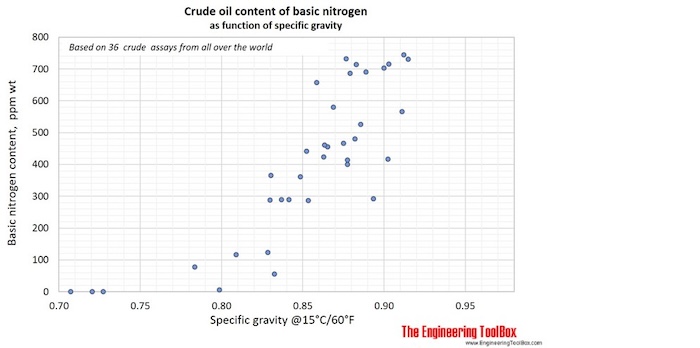
Back to Content Boiling and melting points, density, structure and molweight of organic nitrogen compounds
Phosphorus content
What:
Determination of phosphorus content in volatile distillate fraction of crude oil. Samples containing down to 0.5 mg/kg phosphorus in the volatile fraction can be analyzed by the method.
Why:
Crude oil does not contain phosphorus, however, phosphorus can be present in crude oil due to addition of reservoir chemicals and defoamers under production. Phosphorus will act as catalyst poison in naphtha hydrotreating and reforming processes, and is unwanted in crude oils.
How:
CAPP Test method for determination of organo-phosphorus in volatile distillates of crude oil by Inductively Coupled Plasma (ICP) Optical Emission Spectometry:
A weighed, homogenized crude oil sample is distilled at ambient pressure, to collect a distillate sample from the initial boiling point to 250 °C. The analytical solution is prepared by mixing the fraction with and organic solvent containing a known concentration of standard. Calibration standards are prepared in the same solvent without standard addition. An internal standard is added to the solutions to compensate for variations in test specimen introduction efficiency. The solutions are nebulized into the plasma of the ICP instrument, and the intensities of the emitted light at wavelengths characteristics of phosphorus are measured.
Alternative test methods:
Typical range of variation : 0 - 3 ppm phosphorus in crude oil
Pour point
What:
Determination of the pour point temperatures of crude oils down to − 36°C. Procedure A provides a measure of the maximum (upper) pour point temperature. Procedure B provides a measure of the minimum (lower) pour point temperature. The use of this test method is limited to use for crude oils.
Why:
The pour point of a crude oil is an index of the lowest temperature of handleability for certain applications. This is the only pour point method specifically designed for crude oils. The maximum and minimum pour point temperatures provide a temperature window where a crude oil, depending on its thermal history, might appear in the liquid as well as the solid state. The test method can be used to supplement other measurements of co Phosphorus in gasoline will damage catalytic convertors used in automotive emission control systems, and its level therefore is kept low.
How:
ASTM D5853 Standard Test Method for Pour Point of Crude Oils:
After preliminary heating, the test specimen is cooled at a specified rate and examined at intervals of 3°C for flow characteristics. The lowest temperature at which movement of the test specimen is observed is recorded as the pour point
Alternative test methods: ASTM D97 (for petroleum products)
Typical range of variation : -80 - 30°C (-110 - +90°F) pour point for crude oils
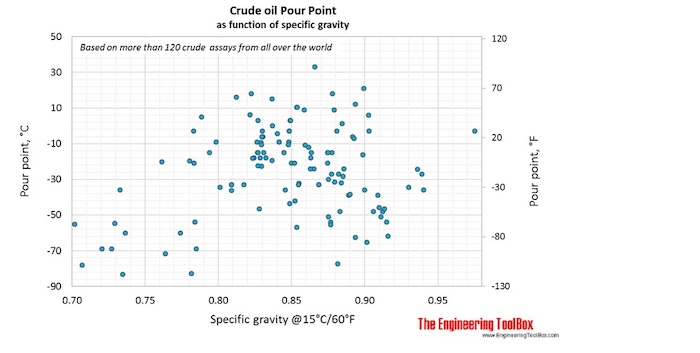
Salt in crude oil
What:
Determination of the approximate chloride (salts) concentration in crude oil. The range of concentration covered is 0 to 500 mg/kg (D3230) or 2 to 1500 mg/kg (D6470) as chloride concentration/volume of crude oil. This test method measures conductivity in the crude oil due to the presence of common chlorides, such as sodium, calcium, and magnesium. Other conductive materials may also be present in the crude oil.
Why:
Th e method is used to determine the approximate chloride content of crude oils, a knowledge of which is important in deciding whether or not the crude oil needs desalting. The efficiency of the process desalter can also be evaluated. Excessive chloride left in the crude oil frequently results in higher corrosion rates in refining units and also has detrimental effects on catalysts used in these units. This test method provides a rapid and convenient means of determining the approximate content of chlorides in crude oil and is useful to crude oil processors.
How:
ASTM D3230 Standard Test Method for Salts in Crude Oil (Electrometric Method):The test method measures the conductivity of a solution of crude oil in a mixed alcohol solvent when subjected to an electrical stress. It measures conductivity due to the presence of inorganic chlorides, and other conductive material, in the crude oil. A homogenized test specimen is dissolved in a mixed alcohol solvent and placed in a test cell consisting of a beaker and a set of electrodes. A voltage is impressed on the electrodes, and the resulting current flow is measured. The chloride (salt) content is obtained by reference to a calibration curve of current versus chloride concentration of known mixtures. Calibration curves are based on standards prepared to approximate the type and concentration of chlorides in the crude oils being tested.
ASTM D6470 Standard Test Method for Salt in Crude Oils (Potentiometric Method):
After homogenizing the crude oil with a mixer, a weighed aliquot is dissolved in xylene at 65°C and extracted with specified volumes of alcohol, acetone, and water in an electrically heated extraction apparatus. A portion of the aqueous extract is analyzed for total halides by potentiometric titration.
Alternative test methods:
Typical range of variation: 1 - 100 mg/kg salt (as NaCl) in crude oil
Sediment, total particulates
What:
Determination of sediment and water (water only D4007, which give "BS&W" - basic sediment and water,) in crude oils. D4807 has been validated for crude oils with sediments up to approximately 0.15 mass %.
Why:
Sediments (suspended solids) and water is not a part of the crude itself, but follows the crude from the reservoir. Both water and sediments are separated from the crude on production site, however, a complete removal is not possible. There are specifications of maximum content of sediments and water for traded crudes (typically limits vary from 0.5 - 2 wt% BS&W). K nowledge about the sediment content of crude oil is important in refinery operations and determination of water and sediment content is also required to measure accurately net volumes of actual oil in sales, taxation, exchanges, and custody transfers.
How:
ASTM D4007 Standard Test Method for Water and Sediment in Crude Oil by the Centrifuge Method (Laboratory Procedure):
Equal volumes of crude oil and water-saturated toluene are placed into a cone-shaped centrifuge tube. After centrifugation, the volume of the higher density water and sediment layer at the bottom of the tube is read.
ASTM D4807 Standard Test Method for Sediment in Crude Oil by Membrane Filtration:
A portion of a representative crude oil sample is dissolved in hot toluene and filtered under vacuum through a 0.45-µm porosity membrane filter. The filter with residue is washed, dried, and weighed to give the final result.
Alternative test methods: ASTM D473
Typical range of variation: Normally not a part of crude assays, but information is given for specific cargoes.
Sulfur, mercaptans
What:
Determination of mercaptan sulfur in typically gasolines, kerosines, aviation turbine fuels, and distillate fuels containing from 0.0003 to 0.01 mass % of mercaptan sulfur. Organic sulfur compounds such as sulfides, disulfides, and thiophene, do not interfere. Elemental sulfur in amounts less than 0.0005 mass % does not interfere. Hydrogen sulfide will interfere if not removed.
Why:
Mercaptan sulfur has an objectionable odor, an adverse effect on fuel system elastomers, and is corrosive to fuel system components.
How:
ASTM D3227 Standard Test Method for (Thiol Mercaptan) Sulfur in Gasoline, Kerosine, Aviation Turbine, and Distillate Fuels (Potentiometric Method):
The hydrogen sulfide-free sample is dissolved in an alcoholic sodium acetate titration solvent and titrated potentiometrically with silver nitrate solution, using as an indicator the potential between a glass reference electrode and a silver/ silver-sulfide indicating electrode. Under these conditions, the mercaptan sulfur is precipitated as silver mercaptide and the end point of the titration is shown by a large change in cell potential.
UOP163 Hydrogen Sulfide and Mercaptan Sulfur in Liquid Hydrocarbons by Potentiometric Titration:
The Liquid hydrocarbon sample is weighed into 2-propanol containing a small amount of ammonium hydroxide. The solution is titrated potentiometrically with alcoholic silver nitrate using a glass reference and silver-silver sulfide indicating electrode system. Hydrogen sulfide and mercaptane sulfur concentrations are calculated as mass ppm.
For determination of mercaptans in whole crude, the methods may need modification due to high viscosity of the crude.
Alternative test methods: IP 342, ISO 3012, JIS K 2276, ASTM D1323
Typical range of variation: 0 - 15 mg/kg mercaptans in crude oil
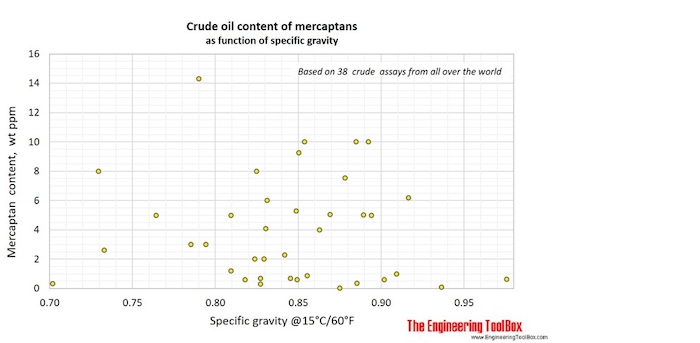
Boiling and melting points, density, structure and molweight of organic sulfur compounds
Sulfur, total
What:
A method covering the measurement of sulfur in hydrocarbons, such as diesel, naphtha, kerosine, jet fuels, crude oils, gasoline (all unleaded), and other distillates. In addition, sulfur in other products, such as M-85 and M-100, may be analyzed using this technique. The applicable concentration range is 0.0150 to 5.00 mass % sulfur.
Why:
The quality of many petroleum products is related to the amount of sulfur present. Knowledge of sulfur concentration is necessary for processing purposes. There are also regulations promulgated in federal, state, and local agencies that restrict the amount of sulfur present in some fuels. This test method provides a means of compliance with specifications or limits set by regulations for sulfur content of petroleum products. Compared to other test methods for sulfur determination, D4294 has high throughput, minimal sample preparation, good precision, and is capable of determining sulfur over a wide range of concentrations. A typical analysis time is 2 to 4 min per sample.
How:
ASTMD4294 Standard Test Method for Sulfur in Petroleum and Petroleum Products by EnergyDispersive X-ray Fluorescence Spectrometry:
The sample is placed in the beam emitted from an X-ray source. The resultant excited characteristic X radiation is measured, and the accumulated count is compared with counts from previously prepared calibration standards that bracket the sample concentration range of interest to obtain the sulfur concentration in mass %.
Alternative test methods: ASTM D2622 and D5453, IP 336 and IP 373, ISO/DIS 14596
Typical range of variation: 0.002 - 4 wt% total sulfur in crude oil
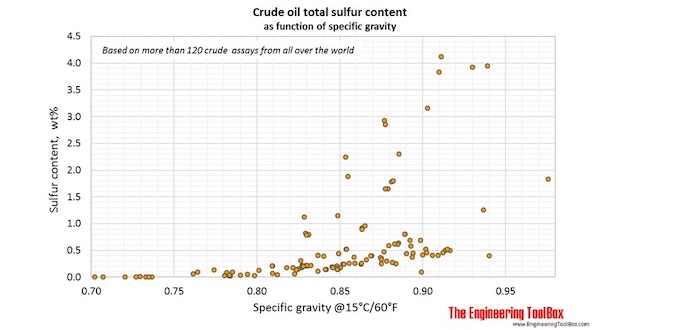
Boiling and melting points, density, structure and molweight of organic sulfur compounds
Trace metal
What:
Determination of nickel, vanadium, iron, sodium and other trace metals in crude oils and residual fuels
Why:
Ni and V are naturally present in the heavy part of crude oil. Corrosion products (iron) come from unlined tanks, piping, pumps, and heat exchangers . Sodium, calcium and other metals are present as salts solved in the small amounts of water following the crude, while silicon may be a part of defoamers used during production. Knowledge of trace elements in crude oil is important because they can have an adverse effect on petroleum refining and product quality. These effects can include catalyst poisoning in the refinery and excessive atmospheric emission in combustion of fuels. Trace element concentrations are also useful in correlating production from different wells and horizons in a field. Elements such as iron, arsenic, silicon and lead are catalyst poisons. Vanadium compounds can cause refractory damage in furnaces. Sodium compounds have been found to cause superficial fusion on fire brick, as well as salt build up causing corrosion and pressure drop in prosessing units. Some organometallic compounds are volatile which can lead to the contamination of distillate fractions, and a reduction in their stability or malfunctions of equipment when they are combusted.
How:
ASTM D5708 Standard Test Methods for Determination of Nickel, Vanadium, and Iron in Crude Oils and Residual Fuels by Inductively Coupled Plasma (ICP) Atomic Emission Spectrometry (AES)
Test Method A: ICP is used to analyze a sample dissolved in an organic solvent. This test method uses oil-soluble metals for calibration and does not purport to quantitatively determine or detect insoluble particulates.
Test Method B: ICP is used to analyze a sample that is decomposed with acid.
ASTM D5863 Standard Test Methods for Determination of Nickel, Vanadium, Iron, and Sodium in Crude Oils and Residual Fuels by Flame Atomic Absorption Spectrometry:
Test Method A: The oil sample are weighed into a beaker and decomposed with concentrated sulfuric acid by heating to dryness. The residual carbon is burned off by heating at 525°C in a muffle furnace. The inorganic residue is digested in dilute nitric acid, evaporated to incipient dryness, dissolved in dilute nitric and made up to volume with dilute nitric acid. Interference suppressant is added to the dilute nitric acid solution. The solution is nebulized into the flame of an atomic absorption spectrometer. A nitrous oxide/acetylene flame is used for vanadium and an air/acetylene flame is used for nickel and iron. The instrument is calibrated with matrix-matched standard solutions. The measured absorption intensities are related to concentrations by the appropriate use of calibration data.
Test Method B: Sample is diluted with an organic solvent to give a test solution containing either 5 % (m/m) or 20 % (m/m) sample. The recommended sample concentration is dependent on the concentrations of the analytes in the sample. For the determination of vanadium, interference suppressant is added to the test solution. The test solution is nebulized into the flame of an atomic absorption spectrometer. A nitrous oxide/acetylene flame is used for vanadium and an air/acetylene flame is used for nickel and sodium. The measured absorption intensities are related to concentrations by the appropriate use of calibration data.
ASTM D7691 Standard Test Method for Multielement Analysis of Crude Oils Using Inductively Coupled Plasma Atomic Emission Spectrometry (ICP-AES):
Inductively coupled plasma-atomic emission spectrometry is a widely used technique in the oil industry. Its advantages over traditional atomic absorption spectrometry (AAS) include greater sensitivity, freedom from molecular interferences, wide dynamic range, and multi-element capability. For analysis of any element using wavelengths below 190 nm, a vacuum or inert gas optical path is required. Calibration, validation and operational guidance is given by standard ASTM D7260.
Alternative test methods:
Typical range of variation :
Ni: 0 - 50 ppm in crude oils
V: 0 - 150 ppm in crude oils
Fe: 0 - 50 ppm in crude oils
Ca: 0 - 150 ppm in crude oils
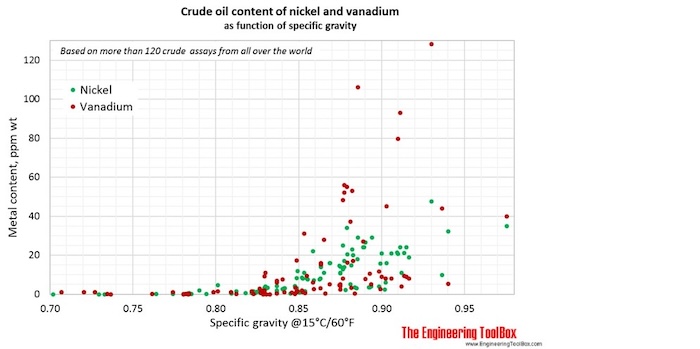
UOP K factor
What:
A method for calculating the UOP Characterization Factor of petroleum oils from API gravity and distillation or viscosity data.
Why:
The UOP Characterization Factor, commonly called K, is indicative of the general origin and nature of a petroleum stock. It is a systematic way of classifying a crude oil according to its paraffinic, naphthenic, intermediate or aromatic nature. Values of 12.5 or higher indicate a material predominantly paraffinic in nature. Highly aromatic materials have characterization factors of 10.0 or less.
How:
UOP375 Calculation of UOP Characterization Factor and Estimation of Molecular Weight of Petroleum Oil
K= (MeABP)1/3/G, Where MeABP is the mean average boiling point, given in degrees Rankine and G is the specific gravity at 60 oF (15.6°C).
Alternative test methods:
Typical range of variation: UOP K for crude oils of 11.0 - 12.5 (normally very small differences, which limits the usefulnes of the method)
Vapour pressure (Reid and Expansion methods)
What:
Determination of the vapor pressure at 37.8 °C (100 °F) of petroleum products and crude oils.
Why:
Vapor pressure of crude oils is of importance to the crude producer and the refiner for general handling and initial refinery treatment. Vapor pressure is critically important for both automotive and aviation gasolines, affecting starting, warm-up, and tendency to vapor lock with high operating temperatures or high altitudes. Maximum vapor pressure limits for gasoline are legally mandated in some areas as a measure of air pollution control. Vapor pressure is also used as an indirect measure of the evaporation rate of volatile petroleum solvents.
How:
ASTM D323 S tandard Test Method for Vapor Pressure of Petroleum Products:(Reid Method) :
The liquid chamber of the vapor pressure apparatus is filled with the chilled sample and connected to the vapor chamber that has been heated to 37.8°C (100°F) in a bath. The assembled apparatus is immersed in a bath at 37.8°C (100°F) until a constant pressure is observed. The reading, suitably corrected, is reported as the Reid vapor pressure. All four procedures utilize liquid and vapor chambers of the same internal volume. Procedure B utilizes a semiautomatic apparatus immersed in a horizontal bath and rotated while attaining equilibrium. Either a Bourdon gage or pressure transducer may be used with this procedure. Procedure C utilizes a liquid chamber with two valved openings. Procedure D requires more stringent limits on the ratio of the liquid and vapor chambers.
ASTM D6377 Standard Test Method for Determination of Vapor Pressure of Crude Oil: VPCRx (Expansion Method):Employing a measuring chamber with a built-in piston, a sample of known volume is drawn from a pressurized sampling system (floating piston cylinder) into the temperature controlled chamber at 20°C or higher. After sealing the chamber, the volume is expanded by moving the piston until the final volume produces the desired V/L value. The temperature of the measuring chamber is then regulated to the measuring temperature. After temperature and pressure equilibrium, the measured pressure is recorded as the VPCRx of the sample. The test specimen shall be mixed during the measuring procedure by shaking the measuring chamber to achieve pressure equilibrium in a reasonable time between 5 and 30 min. For results related to Test Method D 323, the final volume of the measuring chamber shall be five times the test specimen volume and the measuring temperature shall be 37.8°C. This test method is suitable for testing samples that exert a vapor pressure between 25 kPa and 180 kPa at 37.8 °C at vapor-liquid ratios from 4:1 to 0.02:1 (X = 4 to 0.02). This test method is suitable for the determination of the vapor pressure of crude oils at temperatures from 0 °C to 100 °C and pressures up to 500 kPa, but the precision and bias statements may not be applicable.
Alternative test methods: ASTM D5191
Typical range of variation: 0.5 - 12 psi vapour pressur of whole crude at 37.8°C
Viscosity
What:
Methods that specifies procedures for the determination of the kinematic and dynamic viscosity, n, of liquid petroleumproducts, both transparent and opaque. The methods are intended for application to liquids for which primarily the shear stress and shear rates are proportional (Newtonian flow behavior). The range of kinematic viscosities covered by this tese methods is from 0.2 mm2/s to 300 000 mm2/s at all temperatures.
Why:
For crude oil production, viscosity is a major parameter to know for the choice of production methods. Also, for transportation and crude handling, the viscosity is important. Many petroleum products, and some non-petroleum materials, are used as lubricants, and the correct operation of the equipment depends upon the appropriate viscosity of the liquid being used. In addition, the viscosity of many petroleum fuels is important for the estimation of optimum storage, handling, and operational conditions. Thus, the accurate determination of viscosity is essential to many product specifications.
How:
ASTM D445 Standard Test Method for Kinematic Viscosity of Transparent and Opaque Liquids (and Calculation of Dynamic Viscosity):
The time is measured for a fixed volume of liquid to flow under gravity through the capillary of a calibrated viscometer under a reproducible driving head and at a closely controlled and known temperature. The kinematic viscosity (determined value) is the product of the measured flow time and the calibration constant of the viscometer. The dynamic viscosity, can be obtained by multiplying the kinematic viscosity by the density of the liquid.
ASTM D446 Standard Specifications and Operating Instructions for Glass Capillary Kinematic Viscometers
These specifications cover operating instructions for glass capillary kinematic viscometers, also some widely used viscometers suitable for use in accordance with Test Method D 445.
ASTM D7042 Standard Test Method for Dynamic Viscosity and Density of Liquids by Stabinger Viscometer (and the Calculation of Kinematic Viscosity)
The test specimen is introduced into the measuring cells, which are at a closely controlled and known temperature. The measuring cells consist of a pair of rotating concentric cylinders and an oscillating U-tube. The dynamic viscosity is determined from the equilibrium rotational speed of the inner cylinder under the influence of the shear stress of the test specimen and an eddy current brake in conjunction with adjustment data. The density is determined by the oscillation frequency of the U-tube in conjunction with adjustment data. The kinematic viscosity is calculated by dividing the dynamic viscosity by the density.
Alternative test methods: IP 71, ISO 3104, JIS K2283
Typical range of variation:
Viscosity@20°C (68°F): 0.5 - 1000 cSt
Viscosity@40°C (104°F): 0.5 - 130 cSt
Viscosity@50°C (122°F): 0.5 - 70 cSt
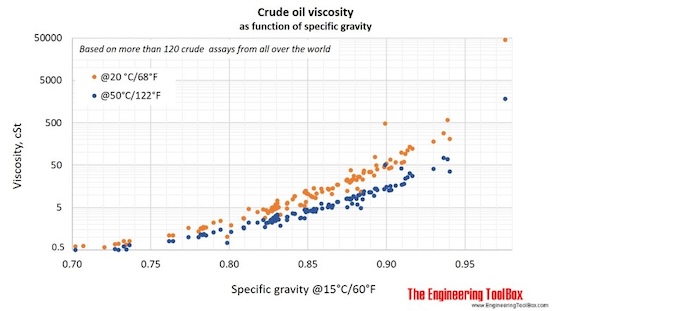
Water content
What:
Direct determination of entrained water in crude oil using automated instrumentation, in the range from 0.02 to 5 mass or volume % water in crude oils.
Why:
Water is not a part of the crude oil itself, but follows the crude from the reservoir. Water is separated from the crude on production site, however, a complete removal is not possible. There are specifications of maximum content of water for traded crudes (typically limits vary from 0.5 - 1.5 wt% water). K nowledge about the water content of crude oil is important in refinery operations but determination of water content is also required to measure accurately net volumes of actual oil in sales, taxation, exchanges, and custody transfers.
How:
ASTM D4377 Standard Test Method for Water in Crude Oils by Potentiometric Karl Fischer Titration:
After homogenizing the crude oil with a mixer, an aliquot of the crude, in a mixed solvent, is titrated to an electrometric end-point using Karl Fischer reagent.
ASTM D4928 Standard Test Method for Water in Crude Oils by Coulometric Karl Fischer Titration:
After homogenizing the crude oil with a mixer, an aliquot is injected into the titration vessel of a Karl Fischer apparatus in which iodine for the Karl Fischer reaction is generated coulometrically at the anode. When all the water has been titrated, excess iodine is detected by an electrometric end-point detector and the titration is terminated. Based on the stoichiometry of the reaction, one mole of iodine reacts with one mole of water, thus the quantity of water is proportional to the total integrated current according to Faraday’s Law
Alternative test methods: ASTM D4006, ASTM D4007, ASTM D6304, IP 386, IP 438, ISO 12937, JIS K 2275
Typical range of variation: 0.1 - 1.5 wt% of water in crude oil ( Normally not a part of crude assays, but information is given for specific cargoes.)
Wax content
What:
A method for estimating the paraffin wax content of petroleum oils and asphalts. Wax content is an empirical value dependent upon the conditions under which the wax is separated from the original material.
Why:
Wax deposition is one of the chronic problems in the petroleum industry. Paraffin waxes consist of straight chain saturated hydrocarbons with carbons atoms ranging from C20 to C50. Paraffin wax consists mostly with normal paraffin content (80–90%), while, the rest consists of branched paraffins (isoparaffins) and cycloparaffins. Waxes may precipitate as the temperature decreases and a solid phase may arise due to their low solubility. For instance, paraffinic waxes can precipitate out when temperature decreases during oil production, transportation through pipelines, and oil storage. The process of solvent dewaxing is used to remove wax from either distillate or residual feedstocks at any stage in the refining process.
How:
UOP46 Paraffin Wax Content of Petroleum Oils and Asphalts:
Paraffin wax content is defined as the mass-percent of material precipitated when a solution of asphalt-free sample in methylene chloride is cooled to -30 C. The lower limit of detection is 5 mass-percent.
Alternative test methods:
Typical range of variation: 0 - 15 wt% of wax in crude oil
